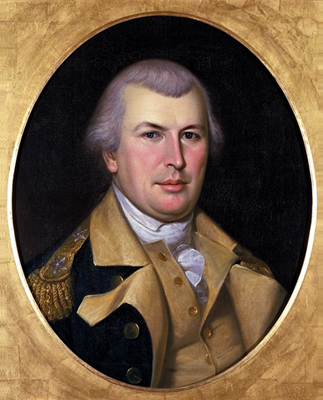
Nathanael Green was one of the Continental Army’s most respected generals during the Revolutionary War, second only to George Washington. Known as the “Savior of the South,” Greene successfully led the army in the southern theater, ending British occupation and turning the tide of the war.
Early Life
Greene was born on August 7, 1742 in Warwick, Rhode Island. Born into a wealthy Quaker family, Greene was well-educated. He had a particular interest in military history, amassing a large collection of books in his personal library. Greene worked blacksmith in his father’s iron foundry and eventually assumed control of the business upon his father’s death. In 1774, Greene married Catharine Littlefield, and they had six children.
Revolutionary War
As a merchant, Greene opposed Britain’s taxation policies in the colonies. After having one of his ships seized by the British, he became even more sympathetic to the plight of the Patriots.
In 1774, Greene helped establish the Kentish Guards, a state militia. However, he was denied the opportunity to serve as an officer because of a limp he had suffered since childhood. Following the early Revolutionary War battles of Lexington and Concord, the Rhode Island Legislature created an army and put Greene in command. He then became a general in Continental Army.
Greene impressed General George Washington during the Boston campaign and was given command of the city following its liberation. Greene went on to serve under Washington in the New York and New Jersey campaign, and later the Philadelphia campaign. In 1778, Greene was appointed quartermaster general of the Continental Army, which placed him in control of managing the army’s limited supplies and transporting its troops.
In October 1780, Greene was named the commander of the Southern Department of the Continental Army. By that time, British Lieutenant General Charles Earl Cornwallis had captured key locations across the region, including most of Georgia. Using guerilla warfare tactics, as well as “divide and conquer” approach, Greene was able to gradually wrestle control from the British, even though he had a much smaller military force.
Cornwallis said of Greene’s relentless harassment of his troops, “[He] is as dangerous as Washington. I never feel secure when encamped in his neighborhood. He is vigilant, enterprising, and full of resources.” By wearing down Cornwallis’ troops, the Continental Army was finally able to defeat the British Army at the Battle of Yorktown, which prompted Cornwallis to surrender.
Later Life
When the war ended, Greene resigned his commission. However, he had used much of his personal wealth to support the war effort. After losing his home in Rhode Island, he moved to a plantation the military granted him, which was known as Mulberry Grove and located outside of Savannah, Georgia.
Greene died suddenly of heatstroke on June 19, 1786, at the age of 44. Upon Greene’s passing, Alexander Hamilton wrote that his death deprived the country of a “universal and pervading genius which qualified him not less for the Senate than for the field.”








